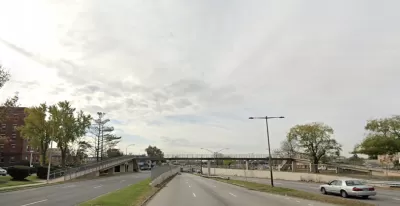Local officials hope to use federal infrastructure funding to make safety improvements on Roosevelt Boulevard, where more than a tenth of the city’s traffic deaths happen.

Philadelphia’s Roosevelt Boulevard, a notoriously dangerous corridor, saw 10 to 13 percent of the city’s total traffic fatalities every year before the pandemic, reports Claudia Lauer for Insurance Journal. “Roosevelt Boulevard is an almost 14-mile maze of chaotic traffic patterns that passes through some of the city’s most diverse neighborhoods and census tracts with the highest poverty rates. Driving can be dangerous with cars traversing between inner and outer lanes, but biking or walking on the boulevard can be even worse with some pedestrian crossings longer than a football field and taking four light cycles to cross.”
Safety advocates hope to see changes coming to the street soon. “Kelley Yemen, director of Philadelphia’s Complete Streets program, said the city is hoping for federal money to begin a long-term redesign of Roosevelt outlined in a study released in 2019. The two options would either make the center lanes a restricted expressway, or cut speeds and convert car lanes to bicycle and transit lanes. Both carry billion-dollar price tags.”
Despite the reduction in overall traffic during the early days of the pandemic, “Around Philadelphia, aggressive driving during the pandemic drove fatalities to 156 in 2020, a sharp increase from 90 deaths in 2019,” notes Lauer. “Data for the first four months of 2022 showed more pedestrians died on Philadelphia roads so far this year than people in cars.”
In an encouraging sign, fatalities on Roosevelt Boulevard did not increase like in much of the city. Safety advocates attribute this to the automated traffic enforcement program that installed speed cameras at eight intersections. “Overall, speeding is down by more than 91% on the road, city and parking authority officials said.”
FULL STORY: Road Safety Strategy Offers Hope for Redesign of Philadelphia’s ‘Corridor of Death’

Alabama: Trump Terminates Settlements for Black Communities Harmed By Raw Sewage
Trump deemed the landmark civil rights agreement “illegal DEI and environmental justice policy.”

Planetizen Federal Action Tracker
A weekly monitor of how Trump’s orders and actions are impacting planners and planning in America.

Why Should We Subsidize Public Transportation?
Many public transit agencies face financial stress due to rising costs, declining fare revenue, and declining subsidies. Transit advocates must provide a strong business case for increasing public transit funding.

How Housing as a Financial Product Harms Communities
Institutional buyers who treat housing as an investment product become disconnected from the impacts of higher rents, displacement, and housing instability.

Blinded by the Light: When Brighter Headlights Decrease Safety
Bright LED headlights can create glare and reduce visibility for other drivers and pedestrians.

Study Links Covid and Poor Driving
The effects of the virus, including ‘brain fog,’ can make driving more difficult and dangerous.
Urban Design for Planners 1: Software Tools
This six-course series explores essential urban design concepts using open source software and equips planners with the tools they need to participate fully in the urban design process.
Planning for Universal Design
Learn the tools for implementing Universal Design in planning regulations.
Caltrans
Smith Gee Studio
Institute for Housing and Urban Development Studies (IHS)
City of Grandview
Harvard GSD Executive Education
Toledo-Lucas County Plan Commissions
Salt Lake City
NYU Wagner Graduate School of Public Service





























